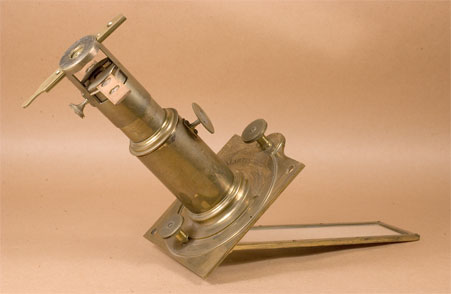 |
|||||
 |
 |
||||
 |
|||||
 |
 |
||||
Benjamin Martin Solar Microscope (No. 275) |
|||||||
 |
Age: c. 1756-1770 Made by: Benjamin Martin Made in: England |
||||||
 |
|||||||
|
Benjamin Martin (1704–1782) was one of the great inventors of the early era of microscopy. He was classically trained in the scientific method, and as such brought a scientific and engineering aspect to early instrumentation. Martin published several books, many popular scientific pamphlets, and gave demonstrations and lectures in the use of all manner of instruments. Early in his career Martin was a demonstrator for John Theophilus Desaguliers, member of the Royal Society of London, and acquaintance to Isaac Newton. Later Martin became a Scientific Lecturer himself. In 1738 he started making optical instruments (at Chichester). During that year he published pamphlets describing a "Universal Microscope" and "Pocket Reflecting Microscope" (an early Drum Microscope). In 1742 he published The Micrographia Nova, considered by Clay and Court to be one of the rarest books concerning microscopy. His invention of the "between lens" around 1759 is one of the important advances for the compound microscope, and appears in all of his optical instruments after this date. Microscope #38 in the Golub Collection shows the Martin 'between-lens". Sales receipts from his shop on Fleet Street in London, near that of George Adams, show that he made approximately 170 different kinds of instruments throughout his career. One type, the Solar Microscope, is presented here. Here is a portrait of Martin. This compound monocular microscope is known as a "solar microscope", as it was intended to be mounted so that the sun would shine, possibly from outside a room, into the instrument via the adjustable mirror. It has six objective lenses on a brass slider, and three additional internal lenses. It has two rack and pinion devices. One allows for fine adjustment of the spring stage, the other, lower thumbscrew changes the tube length. The sample holder is a variation on a spring stage. The instrument is approximately 17cm tall, with a 12x12cm base. It is signed on the circular base, "B. Martin, London". This instrument has one accessory: a four-position sample slide. Similar Martin solar instruments are found in these collections: RMS (241), Billings (49024), Boerhaave (254) |
|||||||
| Featured 08/2007; 01/2121 | |||||||